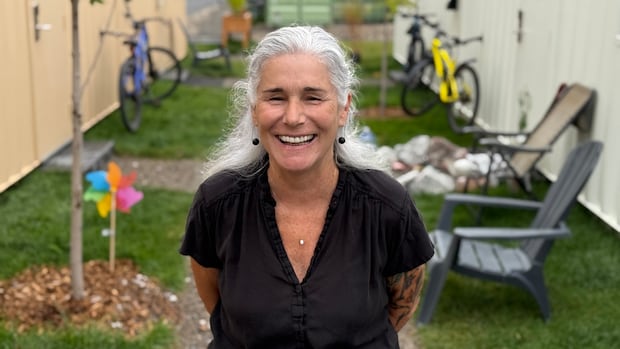OttawaVillage Transitiôn opened in December, and could soon be home to 100 residents who are looking to get off the streets and out of encampments.Opened in December, Village Transitiôn could soon be home to 100Could these shipping containers tackle homelessness in Canada?CBC’s Omar Dabaghi-Pacheco and Ryan Garland got rare access inside Village Transitiôn in Gatineau. The project – a partnership between a developer, non-profit and government – has drawn the attention of other cities in Canada looking for solutions to homelessness. The unique approach is showing early signs of success. The hardest part of Jean-François Bourgon’s transition to apartment living was letting go of the freedom and community he’d come to know after a lifetime on the streets and years living in a sprawling tent city in central Gatineau, Que.”We’re a big family here,” Bourgon said of the dozens of weathered tents and permanently parked RVs in the parking lot of the former Robert Guertin Centre, now demolished. “I was in an apartment for two years and I had to let go of my apartment to come back here because I was missing the place and my friends,” he said.But life here can be rough, too. Robbery, addiction and the struggle to survive are daily realities. Now there’s another option for Bourgon and his neighbours, right on the edge of the parking lot they call home.In the winter of 2023, developer Devcore brought the local business community together to set up heated ice fishing tents at the site, so the growing homeless population could survive the winter.By May 2024, those were removed to pave the way for sturdier shelters made of shipping containers. Village Transitiôn’s first residents moved into their new homes that December. Michel Tremblay is one of the 32 residents who currently call Village Transitiôn home. They could soon be joined by many more. (Omar Dabaghi-Pacheco/CBC)100 living unitsIt’s a compact, fenced-in community of 85 containers transformed into 100 independent living units. Advocates describe it as an important stepping stone from homelessness to independent living, without the isolation that sometimes comes with it. “When you get out of the bush, it’s hard to go [into an] apartment,” said Nancy Martineau, Village Transitiôn’s executive director. “If you don’t have any family, any friends … you need the kind of place like [this].”Inside each container are private housing units complete with a bed, a window, a shower and a private toilet. The community is landscaped with stone walkways, trees and blueberry bushes.It’s a stark contrast to the tent community on the other side of the fence. Martineau said that’s intentional. “If people cannot dream and think about the future, they cannot heal,” she said. “You just have your welfare check, you go on drugs and you just wait for the time to pass because you don’t have any dreams.” Thirty-two residents currently call Village Transitiôn home. No visitors are allowed, and a security guard makes sure of that. A handful of outreach workers and nurses are on hand to help people get to appointments and access care. Everyone here pays a subsidized rent and is responsible for the cost of anything they break — a crucial stepping stone toward taking on a lease and living responsibly, Martineau said.Jean-François Bourgon is back in the nearby encampment after being asked to leave Village Transitiôn. While he said he found it difficult to follow the community’s rule, he said he’d like a second chance at living there. (Omar Dabaghi-Pacheco/CBC)An economical solutionThe container village is run by the non-profit Transitiôn Quebec with a $2-million loan from Devcore. The City of Gatineau invested $1.5 million and has lent the land for 10 years. The province put up $1.14 million in startup costs, plus an additional $894,000 per year for rent subsidies. Rent is roughly 25 per cent of each resident’s income, which is typically limited to their social security and other supports. That brings in roughly $200-$500 dollars a month per resident.Research from the Union des Municipalités du Québec and other studies show each person experiencing homelessness costs the province roughly $70,000 per year. Martineau said Village Transitiôn can house that same person for about $20,000 per year.That’s saving taxpayers about $50 million over the course of the 10-year lease, Martineau said.”We want to be a kind of organization that is going to be able to be free of debt one day,” she said. Following the rulesManon Dessureault has been living at Village Transitiôn for a few months. She said she doesn’t mind paying the rent, but she has mixed feelings about the fence and the strict no-visitors policy.”We pay our rent, but they don’t leave us alone. ‘Do this, do that,'” complained Dessureault, a mother and grandmother.At the same time, she said she’s spent enough time on the streets and in nearby encampments to understand why some separation is needed between the container village and the encampment.”They have to because people were becoming animals, for crying out loud,” she said. “It was crazy, it was a free-for-all. People were getting beat up, getting hurt, getting raped.”It’s not for everyone. After losing his first apartment, Bourgon was accepted into Village Transitiôn, but said he found it hard to adapt to the rules around cleaning and smoking. After repeated warnings to follow those community standards, he was asked to leave.”You’re not allowed to have a visit, no family, no friends, no nothing from outside the containers,” he said. “It’s very sad.”Village Transitiôn is currently conducting interviews for the next round of applicants, and Bourgon said he’s hoping for a second chance.In the nine months since it opened, four residents have left Village Transitiôn to moved into their own independent living units. Dessureault said she’s already thinking about taking that step, too.”To get my own place, get out of here,” she said. “This is good for five years, but I don’t want to be here for five years.”ABOUT THE AUTHOROmar Dabaghi-Pacheco likes to chase the people behind the stories. His pursuit of documentary storytelling has taken him across Canada and to remote areas in Africa. In his off time, you’ll find him engaging in extreme sports around the globe. You can reach Omar at omar.dabaghi-pacheco@cbc.ca.
Monday, 22 Dec 2025
Canada – The Illusion
Search
Have an existing account?
Sign In
© 2022 Foxiz News Network. Ruby Design Company. All Rights Reserved.
You May also Like
- More News:
- history
- Standing Bear Network
- John Gonzalez
- ᐊᔭᐦᑊ ayahp — It happened
- Creation
- Beneath the Water
- Olympic gold medal
- Jim Thorpe
- type O blood
- the bringer of life
- Raven
- Wás’agi
- NoiseCat
- 'Sugarcane'
- The rivers still sing
- ᑲᓂᐸᐏᐟ ᒪᐢᑿ
- ᐅᑳᐤ okâw — We remember
- ᐊᓂᓈᐯᐃᐧᐣ aninâpêwin — Truth
- This is what it means to be human.
- Nokoma











